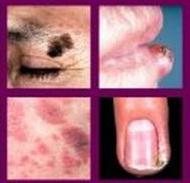Dermatology is closely related to such areas of medicine, oncology, endocrinology, gynecology, urology, neurology, hematology, psychiatry and infectious diseases. But the closest to this area of science is a venereology.
There are also more specific directions in dermatology which are exploring certain diseases and pathologies:
- Mycology - Section of Dermatology, who is studying fungal diseases.
- Dermatocosmetology - medical science that deals with the identification of the causes and development of techniques to eliminate cosmetic defects of the skin.
- Trichology - specializes in diseases of the hair.
- Dermatooncology - studies of skin tumors, explores their goodness.
- Pediatric dermatology - particularly studies of skin diseases in children;
- Gerontodermatology - direction of Dermatology, involved in treatment of skin diseases in elderly and senile age.
Skin diseases: causes and symptoms
Functional diversity of the skin, particularly its structure and its impact on a significant number of internal and external factors, characterized by a variety of dermatological diseases, the so-called of dermatoses.
- The external (exogenous) of factors affecting the occurrence of certain skin diseases include:
biological factors that cause:
fungal skin - mycosis: microsporia, athlete;
viral infection - warts, herpes;
pustular disease - pyoderma: hydradenitis, furunculosis, impetigo;
the parasitic lesions - scabies, lice.
chemical and physical factors that lead to inflammatory skin diseases - dermatitis: diaper rash, scrapes, burns.
- A huge influence on the appearance of many skin diseases render internal factors:
metabolic disorders;
internal diseases systems of man;
diseases of the nervous system;
hypovitaminosis;
chronic foci of infection.
The most common signs of dermatological diseases, at the appearance of which it is necessary to consult a dermatologist:
skin rashes;
changes of relief and skin color;
burning, itching, soreness of the skin.
Dermatologic Diseases
The greatest value among dermatological diseases have a parasitic, infectious and viral diseases of the skin, its defeat in the interaction with the environment (physical and chemical factors).
Among the ailments that studying dermatology: psoriasis; shingles; dermatitis; vitiligo; balanoposthitis; ichthyosis; warts; pyoderma; prurigo; rubrofitii; seborrhea; drug reaction; eczema; erythrasma.
In most cases, dermatologists faced by with such skin diseases as psoriasis, acne, fungal diseases, warts, eczema, dermatitis, herpes.
Diagnosis and treatment of skin diseases
The latest techniques make it possible to quickly and accurately determine the cause of a skin disease and prescribe an effective treatment of the skin.
In modern dermatology apply the latest diagnostic techniques exploring the skin, nails, hair, mucous membranes: X-ray, laboratory, instrumental, skin tests.
Treatment of skin diseases require from the patient's - patience and strictly implement all the recommendations of the doctor. The main role in the successful treatment adherence plays medicinal therapy and diet, proper hygiene of the affected skin. In the treatment of skin diseases is widely used hardware and physiotherapy procedures, herbal medicine, spa treatment, psychotherapy.
hide
 Dermatologist - a specialist in the field of medicine that deals with the diagnosis, treatment and prevention of diseases of the epidermis, hair and nails.
Dermatologist - a specialist in the field of medicine that deals with the diagnosis, treatment and prevention of diseases of the epidermis, hair and nails. 







